Founded in 1938 and published semiannually by Sophia University MN 62:2 (2007) 135–77Female Readers and Early Heian Romances: The Hakubyō Tales of Ise Illustrated Scroll FragmentsJoshua S. Mostow
MN 62:2 (2007) 135–77Female Readers and Early Heian Romances: The Hakubyō Tales of Ise Illustrated Scroll FragmentsJoshua S. Mostow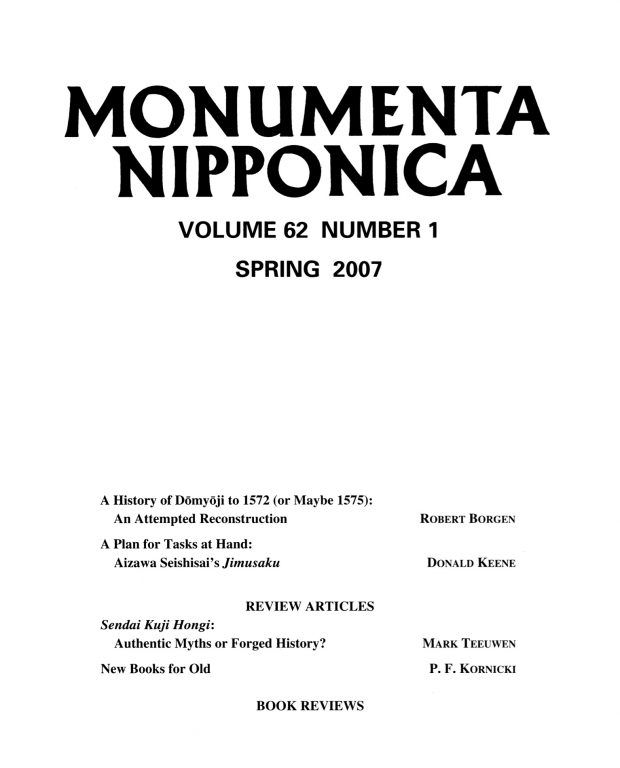 MN 62:1 (2007) 75–86A Plan for Tasks at Hand: Aizawa Seishisai’s JimusakuDonald Keene
MN 62:1 (2007) 75–86A Plan for Tasks at Hand: Aizawa Seishisai’s JimusakuDonald Keene MN 62:1 (2007) 80–86A Plan for Tasks at HandAizawa Seishisai, Translated by Donald Keene
MN 62:1 (2007) 80–86A Plan for Tasks at HandAizawa Seishisai, Translated by Donald Keene MN 62:1 (2007) 87–96Sendai Kuji Hongi: Authentic Myths or Forged History?Mark Teeuwen
MN 62:1 (2007) 87–96Sendai Kuji Hongi: Authentic Myths or Forged History?Mark Teeuwen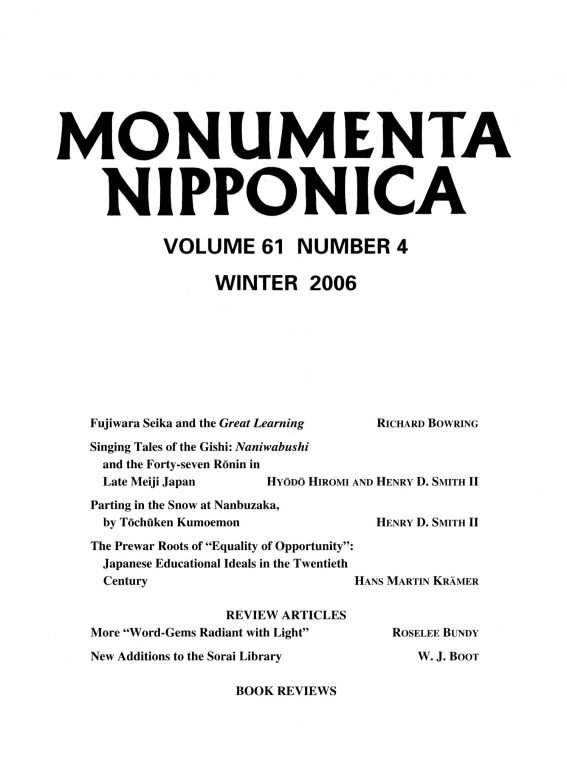 MN 61:4 (2006) 459–508Singing Tales of the Gishi: Naniwabushi and the Forty-seven Rōnin in Late Meiji JapanHenry D. Smith II and Hiromi Hyōdō
MN 61:4 (2006) 459–508Singing Tales of the Gishi: Naniwabushi and the Forty-seven Rōnin in Late Meiji JapanHenry D. Smith II and Hiromi Hyōdō MN 61:4 (2006) 509–519Parting in the Snow at NanbuzakaTōchūken Kumoemon, Translated by Henry D. Smith II
MN 61:4 (2006) 509–519Parting in the Snow at NanbuzakaTōchūken Kumoemon, Translated by Henry D. Smith II MN 61:4 (2006) 551–558More “Word-Gems Radiant with Light”Roselee Bundy
MN 61:4 (2006) 551–558More “Word-Gems Radiant with Light”Roselee Bundy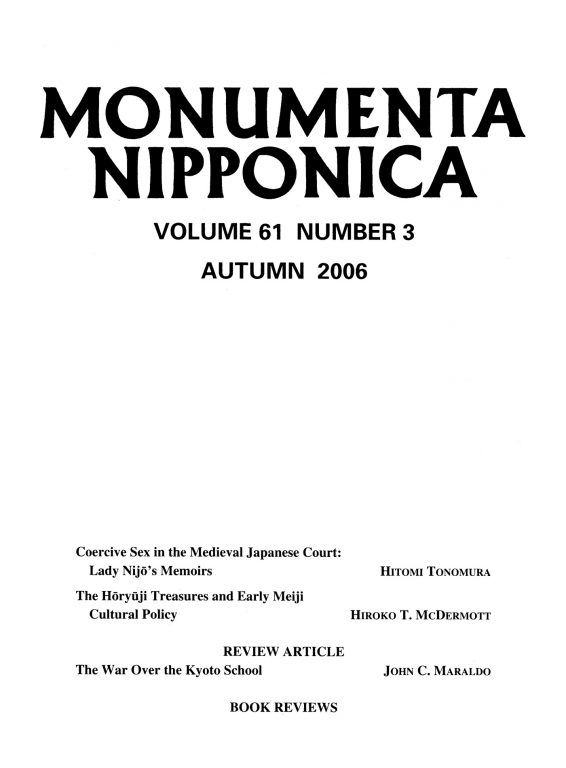 MN 61:3 (2006) 283–338Coercive Sex in the Medieval Japanese Court: Lady Nijō’s MemoirHitomi Tonomura
MN 61:3 (2006) 283–338Coercive Sex in the Medieval Japanese Court: Lady Nijō’s MemoirHitomi Tonomura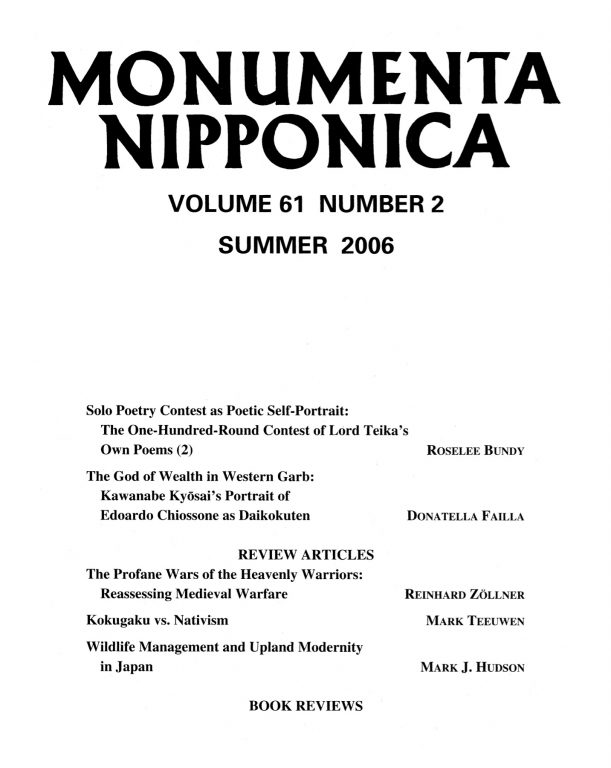 MN 61:2 (2006) 131–92Solo Poetry Contest as Poetic Self-Portrait: The One-Hundred-Round Contest of Lord Teika’s Own Poems (Part 2)Roselee Bundy
MN 61:2 (2006) 131–92Solo Poetry Contest as Poetic Self-Portrait: The One-Hundred-Round Contest of Lord Teika’s Own Poems (Part 2)Roselee Bundy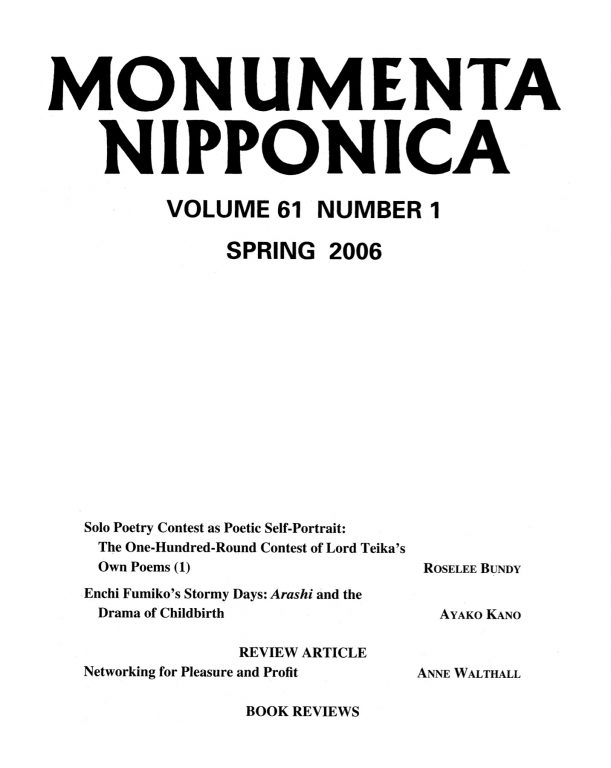 MN 61:1 (2006) 1–58Solo Poetry Contest as Poetic Self-Portrait: The One-Hundred-Round Contest of Lord Teika’s Own Poems (Part 1)Roselee Bundy
MN 61:1 (2006) 1–58Solo Poetry Contest as Poetic Self-Portrait: The One-Hundred-Round Contest of Lord Teika’s Own Poems (Part 1)Roselee Bundy MN 61:1 (2006) 59–91Enchi Fumiko’s Stormy Days: Arashi and the Drama of ChildbirthAyako Kano
MN 61:1 (2006) 59–91Enchi Fumiko’s Stormy Days: Arashi and the Drama of ChildbirthAyako Kano MN 61:1 (2006) 71–91The Storm: A Play in Three ActsEnchi Fumiko, Translated by Ayako Kano
MN 61:1 (2006) 71–91The Storm: A Play in Three ActsEnchi Fumiko, Translated by Ayako Kano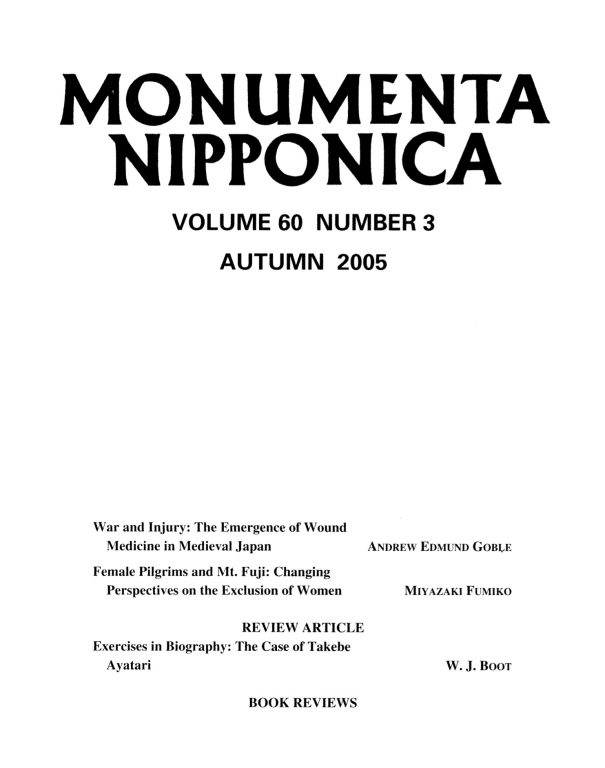 MN 60:3 (2005) 393–407Exercises in Biography: The Case of Takebe AyatariW. J. Boot
MN 60:3 (2005) 393–407Exercises in Biography: The Case of Takebe AyatariW. J. Boot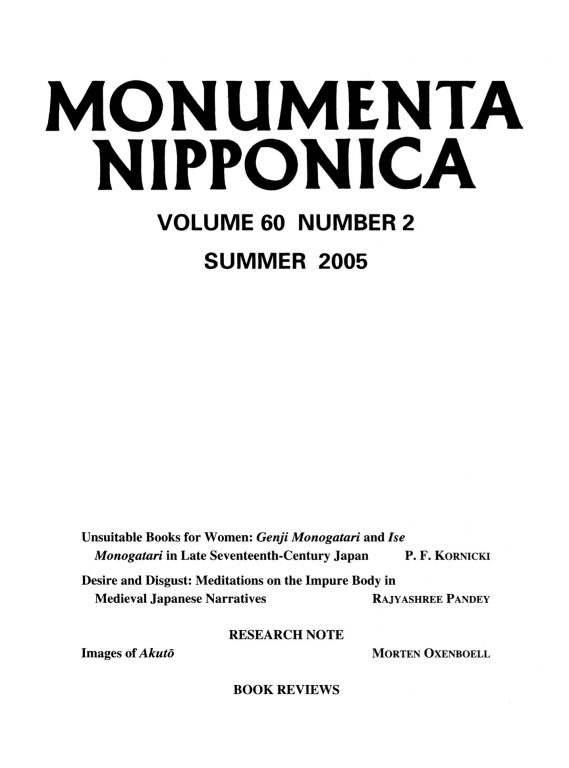 MN 60:2 (2005) 147–93Unsuitable Books for Women?: Genji Monogatari and Ise Monogatari in Late Seventeenth-Century JapanPeter F. Kornicki
MN 60:2 (2005) 147–93Unsuitable Books for Women?: Genji Monogatari and Ise Monogatari in Late Seventeenth-Century JapanPeter F. Kornicki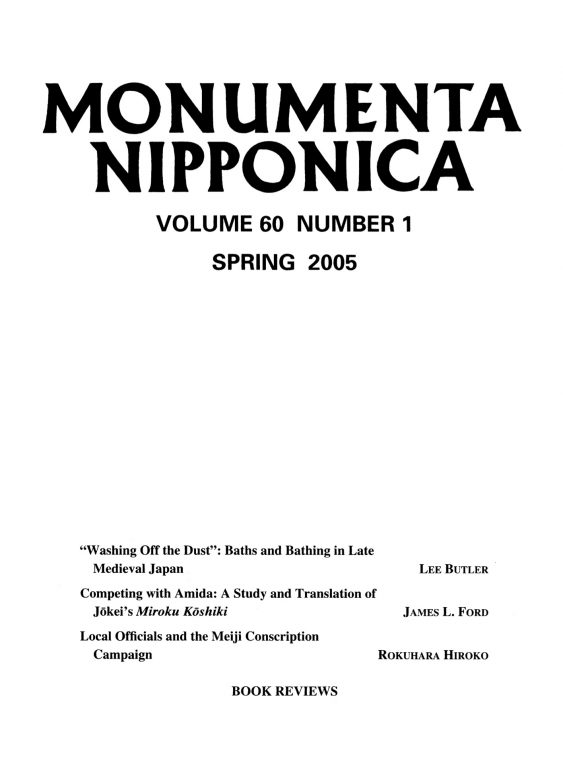 MN 60:1 (2005) 43–79Competing with Amida: A Study and Translation of Jōkei’s Miroku KōshikiJames L. Ford
MN 60:1 (2005) 43–79Competing with Amida: A Study and Translation of Jōkei’s Miroku KōshikiJames L. Ford MN 60:1 (2005) 65–79Jōkei’s Five Part Miroku Kōshiki (c. 1196): A TranslationJōkei, Translated by James L. Ford
MN 60:1 (2005) 65–79Jōkei’s Five Part Miroku Kōshiki (c. 1196): A TranslationJōkei, Translated by James L. Ford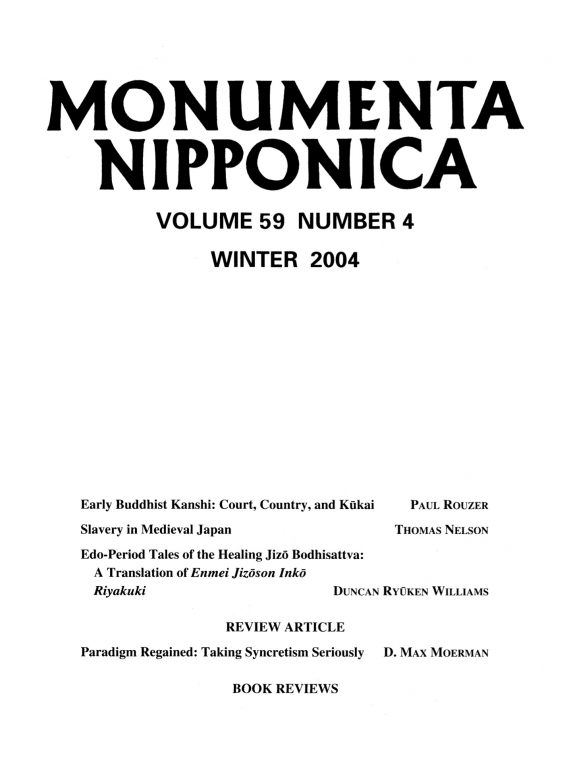 MN 59:4 (2004) 431–61Early Buddhist Kanshi: Court, Country, and KūkaiPaul Rouzer
MN 59:4 (2004) 431–61Early Buddhist Kanshi: Court, Country, and KūkaiPaul Rouzer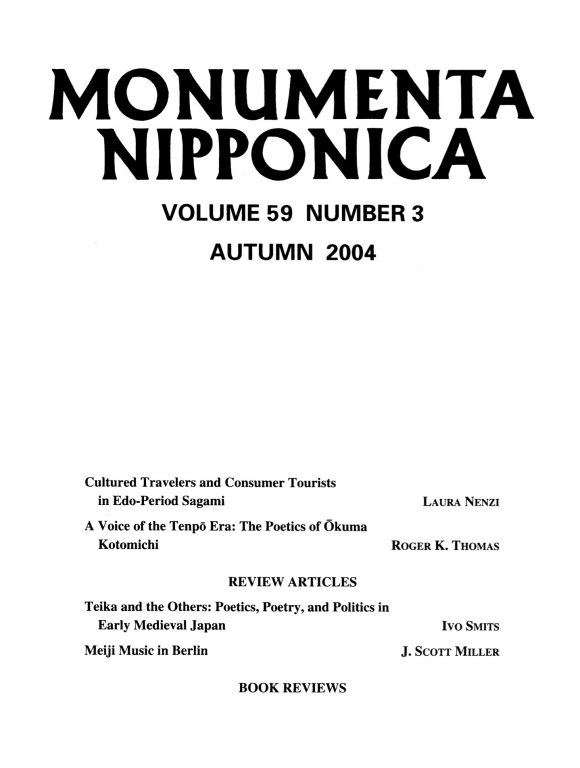 MN 59:3 (2004) 321–58A Voice of the Tenpō Era: The Poetics of Ōkuma KotomichiRoger K. Thomas
MN 59:3 (2004) 321–58A Voice of the Tenpō Era: The Poetics of Ōkuma KotomichiRoger K. Thomas MN 59:3 (2004) 337–58MonologueKotomichi Ōkuma, Translated by Roger K. Thomas
MN 59:3 (2004) 337–58MonologueKotomichi Ōkuma, Translated by Roger K. Thomas MN 59:3 (2004) 359–89Teika and the Others: Poetics, Poetry, and Politics in Early Medieval JapanIvo Smits
MN 59:3 (2004) 359–89Teika and the Others: Poetics, Poetry, and Politics in Early Medieval JapanIvo Smits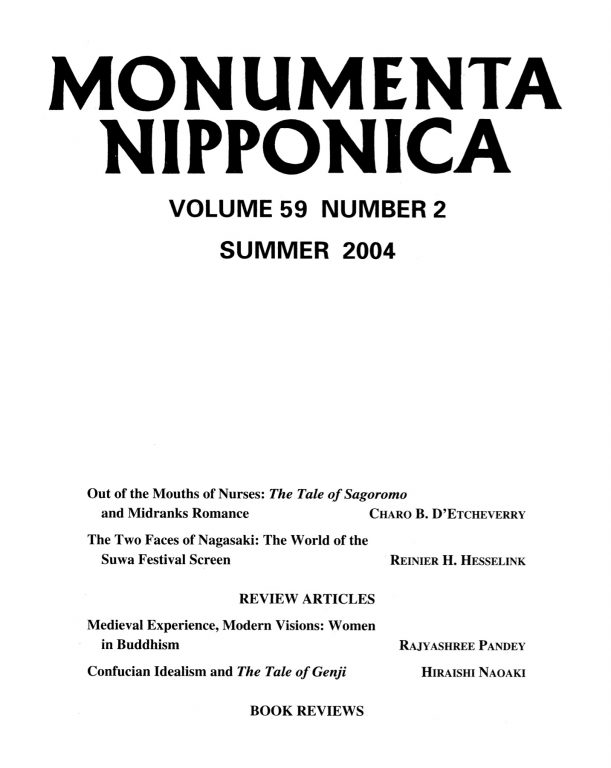 MN 59:2 (2004) 153–77Out of the Mouths of Nurses: “The Tale of Sagoromo” and Midranks RomanceCharo B. D'Etcheverry
MN 59:2 (2004) 153–77Out of the Mouths of Nurses: “The Tale of Sagoromo” and Midranks RomanceCharo B. D'Etcheverry MN 59:2 (2004) 245–55Confucian Idealism and “The Tale of Genji”Naoaki Hiraishi
MN 59:2 (2004) 245–55Confucian Idealism and “The Tale of Genji”Naoaki Hiraishi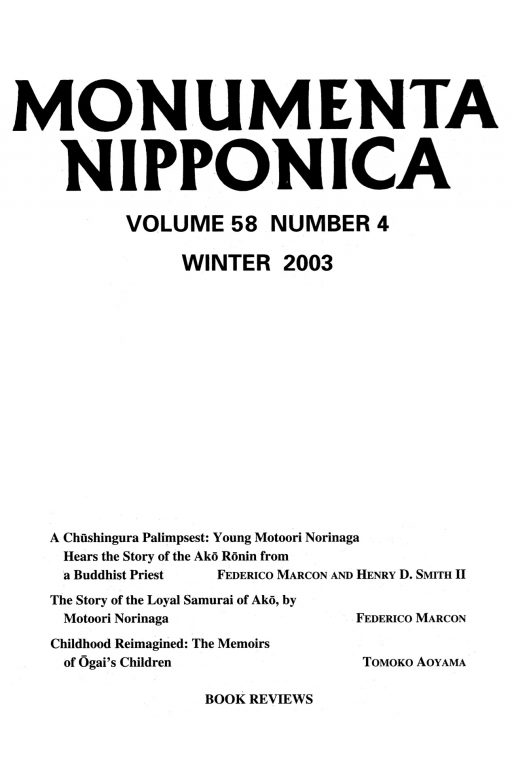 MN 58:4 (2003) 439–93A Chūshingura Palimpsest: Young Motoori Norinaga Hears the Story of the Akō Rōnin from a Buddhist PriestFederico Marcon and Henry D. Smith II
MN 58:4 (2003) 439–93A Chūshingura Palimpsest: Young Motoori Norinaga Hears the Story of the Akō Rōnin from a Buddhist PriestFederico Marcon and Henry D. Smith II MN 58:4 (2003) 467–93The Story of the Loyal Samurai of AkōMotoori Norinaga, Translated by Federico Marcon
MN 58:4 (2003) 467–93The Story of the Loyal Samurai of AkōMotoori Norinaga, Translated by Federico Marcon MN 58:4 (2003) 495–529Childhood Reimagined: The Memoirs of Ōgai’s ChildrenTomoko Aoyama
MN 58:4 (2003) 495–529Childhood Reimagined: The Memoirs of Ōgai’s ChildrenTomoko Aoyama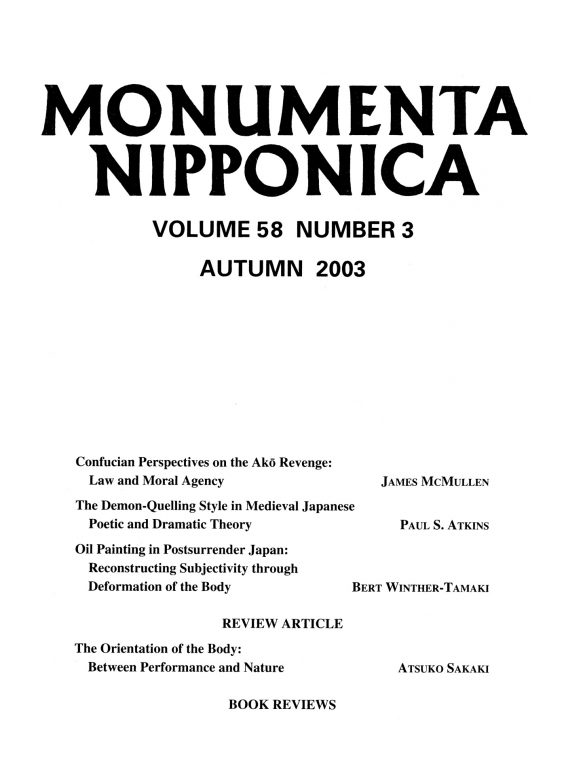 MN 58:3 (2003) 317–46The Demon-Quelling Style in Medieval Japanese Poetic and Dramatic TheoryPaul S. Atkins
MN 58:3 (2003) 317–46The Demon-Quelling Style in Medieval Japanese Poetic and Dramatic TheoryPaul S. Atkins MN 58:3 (2003) 397–405The Orientation of the Body: Between Performance and NatureAtsuko Sakaki
MN 58:3 (2003) 397–405The Orientation of the Body: Between Performance and NatureAtsuko Sakaki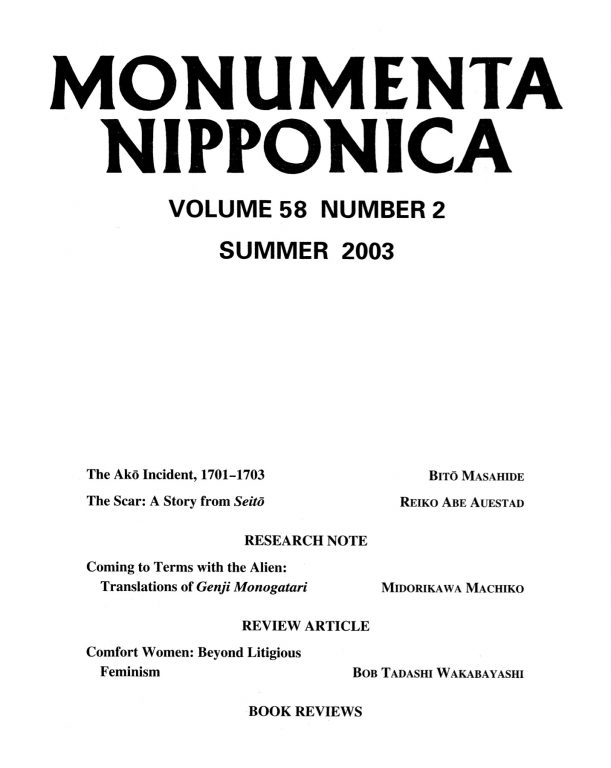 MN 58:2 (2003) 171–92The Scar: A Story from SeitōReiko Abe Auestad
MN 58:2 (2003) 171–92The Scar: A Story from SeitōReiko Abe Auestad MN 58:2 (2003) 181–92The ScarSatō Kinko, Translated by Reiko Abe Auestad
MN 58:2 (2003) 181–92The ScarSatō Kinko, Translated by Reiko Abe Auestad MN 58:2 (2003) 193–222Coming to Terms with the Alien: Translations of “Genji Monogatari”Machiko Midorikawa
MN 58:2 (2003) 193–222Coming to Terms with the Alien: Translations of “Genji Monogatari”Machiko Midorikawa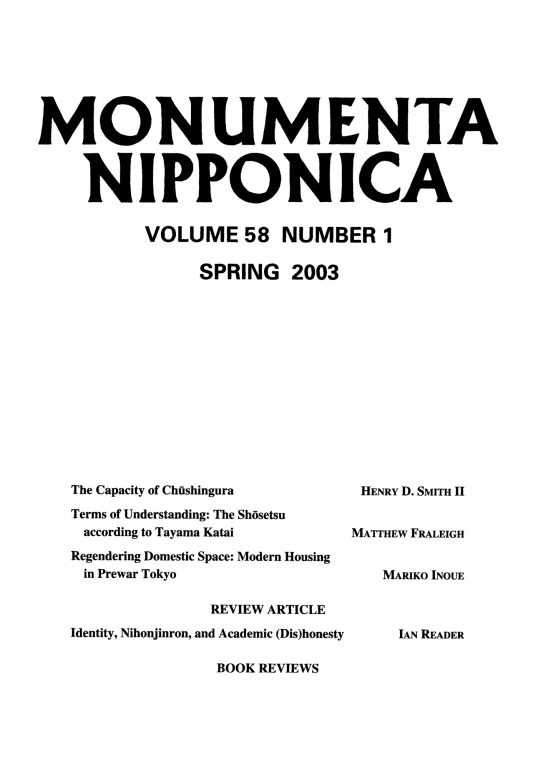 MN 58:1 (2003) 43–78Terms of Understanding: The Shōsetsu according to Tayama KataiMatthew Fraleigh
MN 58:1 (2003) 43–78Terms of Understanding: The Shōsetsu according to Tayama KataiMatthew Fraleigh MN 57:4 (2002) 473–507Koganei Kimiko: A Meiji-Born Woman WriterAngela Yiu
MN 57:4 (2002) 473–507Koganei Kimiko: A Meiji-Born Woman WriterAngela Yiu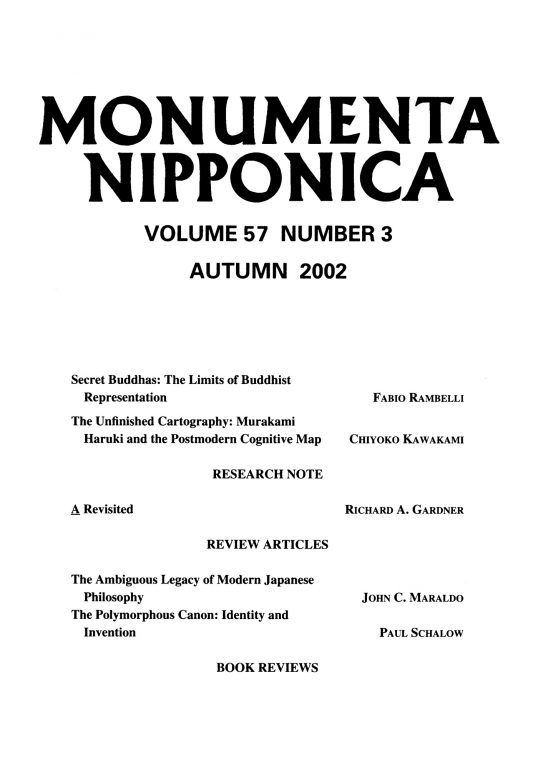 MN 57:3 (2002) 309–37The Unfinished Cartography: Murakami Haruki and the Postmodern Cognitive MapChiyoko Kawakami
MN 57:3 (2002) 309–37The Unfinished Cartography: Murakami Haruki and the Postmodern Cognitive MapChiyoko Kawakami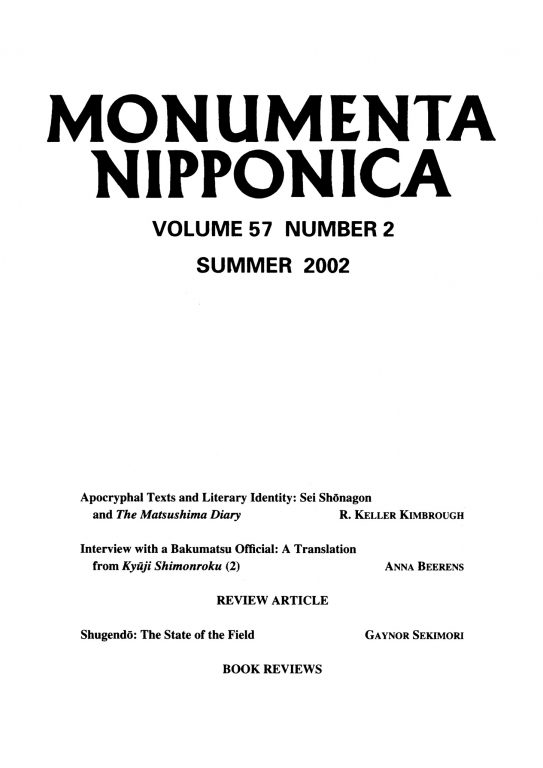 MN 57:2 (2002) 133–71Apocryphal Texts and Literary Identity: Sei Shōnagon and “The Matsushima Diary”R. Keller Kimbrough
MN 57:2 (2002) 133–71Apocryphal Texts and Literary Identity: Sei Shōnagon and “The Matsushima Diary”R. Keller Kimbrough MN 57:2 (2002) 157–71The Matsushima DiarySei Shōnagon, Translated by R. Keller Kimbrough
MN 57:2 (2002) 157–71The Matsushima DiarySei Shōnagon, Translated by R. Keller Kimbrough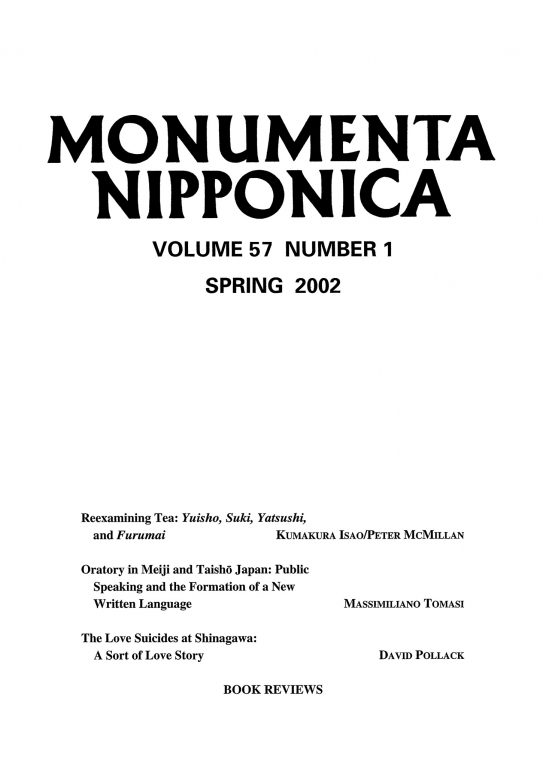 MN 57:1 (2002) 73–89The Love Suicides at Shinagawa: A Sort of Love StoryDavid Pollack
MN 57:1 (2002) 73–89The Love Suicides at Shinagawa: A Sort of Love StoryDavid Pollack MN 57:1 (2002) 78–89The Love Suicides at ShinagawaEdited by David Pollack
MN 57:1 (2002) 78–89The Love Suicides at ShinagawaEdited by David Pollack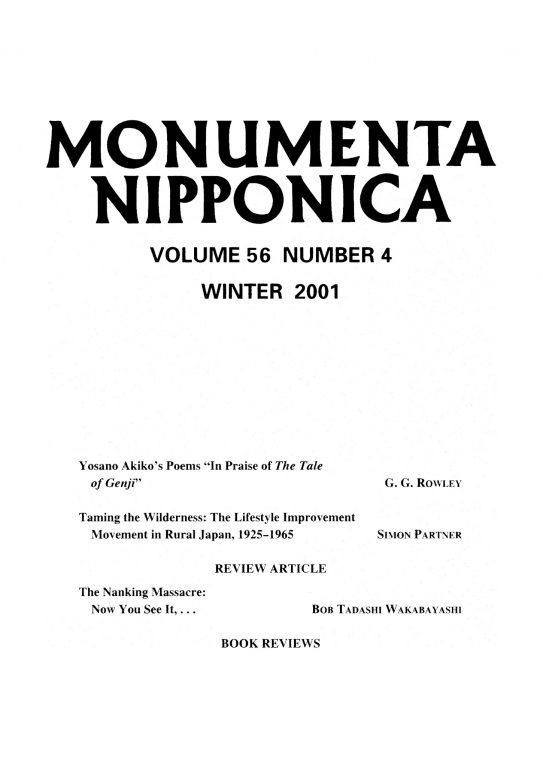 MN 56:4 (2001) 439–86Yosano Akiko’s Poems: “In Praise of The Tale of Genji”G. G. Rowley
MN 56:4 (2001) 439–86Yosano Akiko’s Poems: “In Praise of The Tale of Genji”G. G. Rowley MN 56:4 (2001) 459–86In Praise of The Tale of GenjiAkiko Yosano, Translated by G. G. Rowley
MN 56:4 (2001) 459–86In Praise of The Tale of GenjiAkiko Yosano, Translated by G. G. Rowley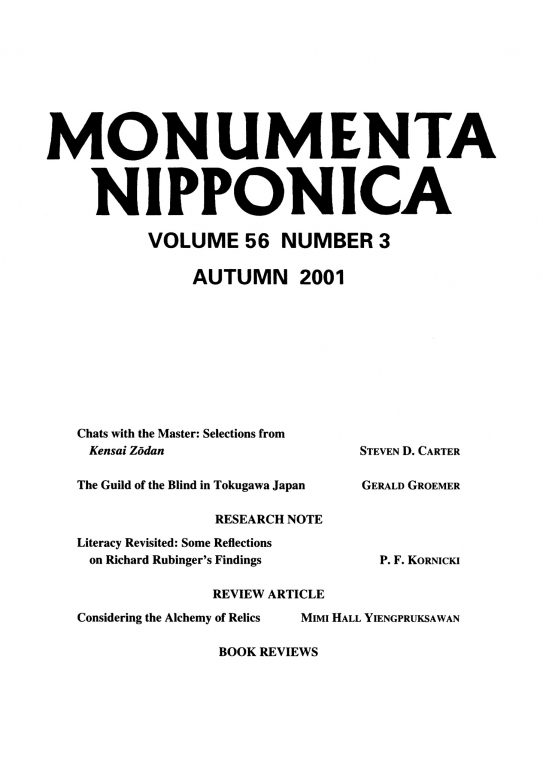 MN 56:3 (2001) 295–347Chats with the Master: Selections from “Kensai Zōdan”Steven D. Carter
MN 56:3 (2001) 295–347Chats with the Master: Selections from “Kensai Zōdan”Steven D. Carter MN 56:3 (2001) 305–47Chats with KensaiKensai, Translated by Steven D. Carter
MN 56:3 (2001) 305–47Chats with KensaiKensai, Translated by Steven D. Carter MN 56:1 (2001) 93–98Families-at-Risk in a Medieval TaleWilliam R. LaFleur
MN 56:1 (2001) 93–98Families-at-Risk in a Medieval TaleWilliam R. LaFleur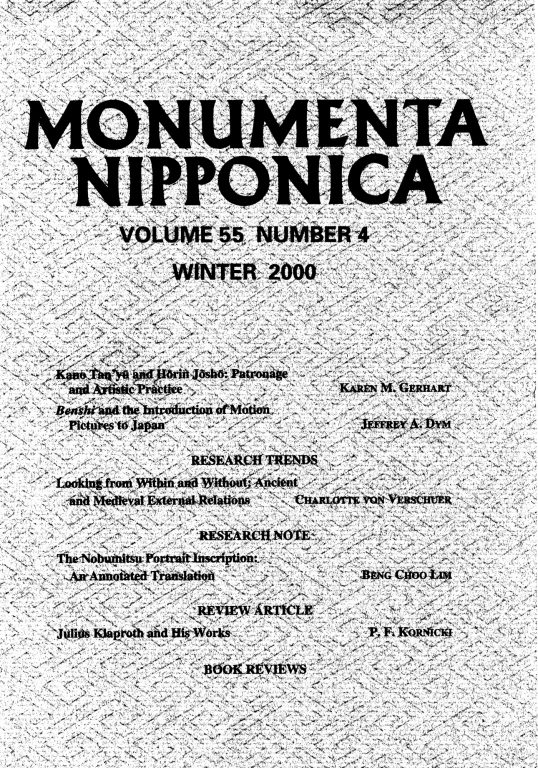 MN 55:4 (2000) 567–577The Nobumitsu Portrait Inscription: An Annotated TranslationBeng Choo Lim
MN 55:4 (2000) 567–577The Nobumitsu Portrait Inscription: An Annotated TranslationBeng Choo Lim MN 55:4 (2000) 572–577Nobumitsu GazōsanKeijo Shūrin, Translated by Beng Choo Lim
MN 55:4 (2000) 572–577Nobumitsu GazōsanKeijo Shūrin, Translated by Beng Choo Lim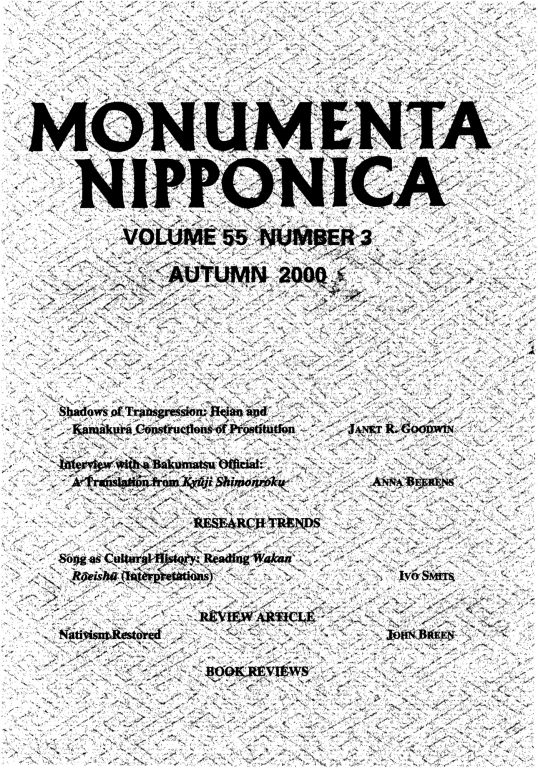 MN 55:3 (2000) 399–427Song as Cultural History: Reading Wakan Rōeishū (Part 2: Interpretations)Ivo Smits
MN 55:3 (2000) 399–427Song as Cultural History: Reading Wakan Rōeishū (Part 2: Interpretations)Ivo Smits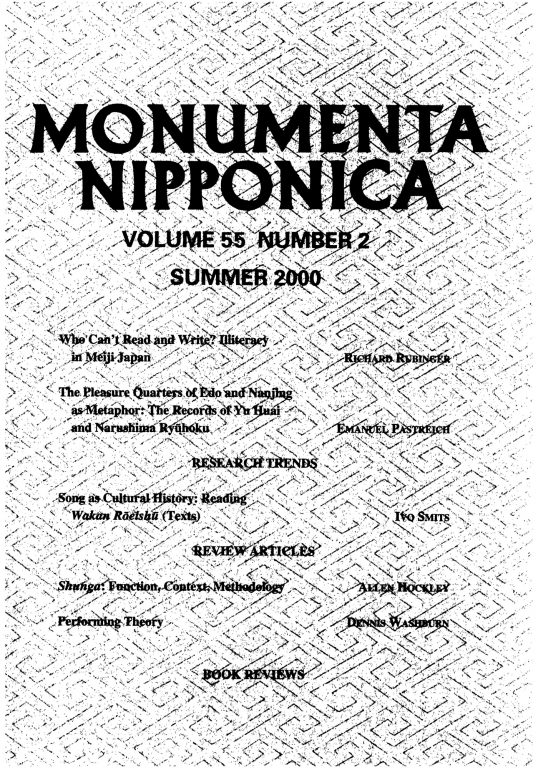 MN 55:2 (2000) 225–56Song as Cultural History: Reading Wakan Rōeishū (Part 1: Texts)Ivo Smits
MN 55:2 (2000) 225–56Song as Cultural History: Reading Wakan Rōeishū (Part 1: Texts)Ivo Smits MN 55:2 (2000) 271–81Performing TheoryDennis Washburn
MN 55:2 (2000) 271–81Performing TheoryDennis Washburn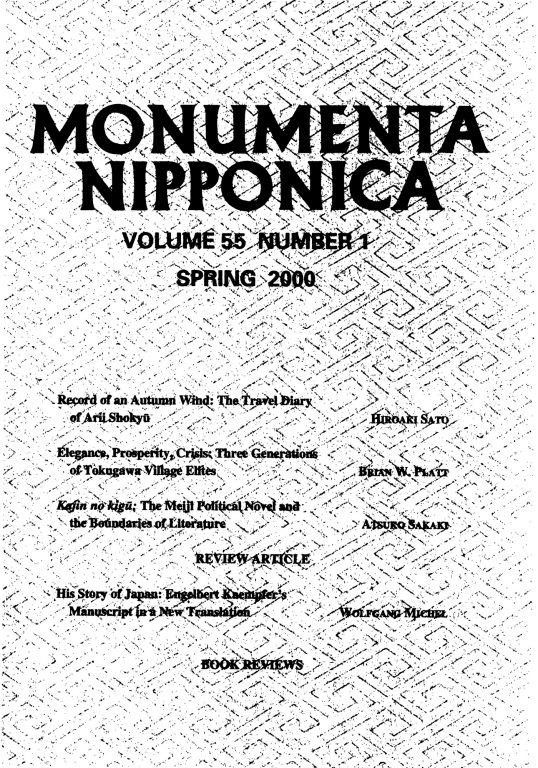 MN 55:1 (2000) 1–43Record of an Autumn Wind: The Travel Diary of Arii ShokyūHiroaki Sato
MN 55:1 (2000) 1–43Record of an Autumn Wind: The Travel Diary of Arii ShokyūHiroaki Sato


























